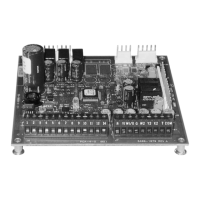122 RT-SVD03G-EN
CO
2
Sensor Connections (ReliaTel Units with Demand Controlled Ventilation)
When the space CO
2
level drops below the CO
2
Setpoint, the supply fan will be de-energized and
the OA damper will close to 0%.
Failure and Override Conditions
1. If the CO
2
value goes invalid while DCV is enabled:
a. A CO
2
Sensor failure diagnostic is called out.
b. DCV is disabled.
c. Design Min Position Setpoint will be used for the Damper Min Position
d. After power is cycled to the unit, the CO
2
sensor failure diagnostic is cleared and DCV is
disabled.
2. For all configurations, (RTEM, RTRM 8.0, Honeywell, etc.) if a CO
2
sensor value becomes valid
at any point during unit operation the unit will utilize the value and perform Demand Controlled
Ventilation.
3. If a Ventilation Override Mode goes active it will take priority over DCV.
4. If an Emergency Override Mode goes active it will take priority over DCV.
5. Any BAS Economizer minimum position request takes priority over DCV.
6. The remote minimum position input will be used as the Design Minimum Position Setpoint
when connected.
Honeywell Operation
When the indoor CO
2
level rises above the DCV setpoint (upper limit), the supply fan will energize,
and a PID control loop modulates the position of the outdoor-air damper to bring in more outdoor
air to maintain indoor CO
2
level at this upper limit (the operation of compressors or heat are not
affected; they still operate to maintain space or discharge air temperature at setpoint). When the
indoor CO
2
level drops back below this limit minus 50 PPM, the outdoor-air damper is allowed to
return to its minimum position and the supply fan is allowed to de-energize if no longer requested.
Note: When using CO
2
-based demand controlled ventilation with the ReliaTel controller, the
minimum OA damper position should be set to be less then the code required design
ventilation rate for the system. See HVAC Knowledge Center case #4144 for guidance on
determining the indoor CO
2
setpoint and minimum OA damper position for a given
application.
As a safety precaution, if the mixed air temperature drops to 40º F, the mixed air sensor overrides
DCV control and closes the outdoor-air damper to its minimum position to protect the gas heat
exchanger (or to prevent water coils, if installed, from freezing). When the mixed air temperature
rises to 43º F, DCV control reverts to normal.
Note: Since it is possible for the outdoor air damper to drive wide open, it is also recommended
to install an evaporative defrost control to prevent the evaporator coil from freezing (Frostat
is a standard feature on the Voyager Commercial 27.5 - 50 ton units).
Voyager 27.5 - 50 tons VAV Notes
• During morning warm-up (MWU), the DCV setpoint is ignored.
• During unoccupied mode, the DCV setpoint is ignored.
• During occupied cooling or daytime warm-up (DWU) mode, DCV control is allowed.

